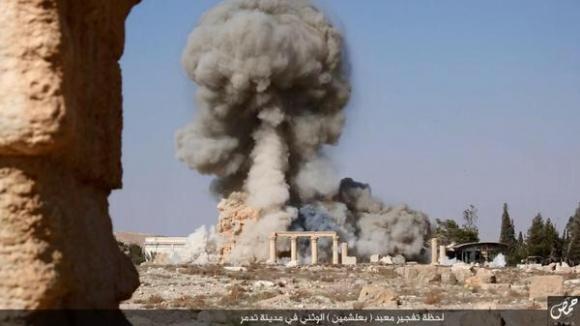The war against the historical finds of antiquity declared by the Islamic State, is part of a codified and systematic campaign of cultural annihilation. That appetite, which seems insatiable, in destroying priceless sites and artifacts, is much more structured and organized than one might believe because the illicit sale of antiquities guarantees a constant economic flow, despite international efforts to stop the traffic of treasures at the black market. Reason why on one hand we witness, powerlessly, the destruction of the Temple of Baalshamin, located within the majestic ruins of the Palmyra desert, on the other we are absolutely certain that the structure was ransacked of anything stored inside it before to be razed to the ground.
According to the ideology of the Islamic State, which controls vast areas of Iraq and Syria, places that host some of the most precious ruins in the Middle East, the destruction of these works is a campaign against paganism and idolatry, anathema for the his radical interpretation of Islam. The Baalshamin Temple, for example, is dedicated to a god of the Phonician storm.
Last week, militants used a bulldozer to tear apart the Monastery of St. Elias, in central Syria, which housed the saint's remains and which, in the past, was an important Christian pilgrimage site. The destruction of antiquities is now a recurring pattern.
The looting that took place last February at the museum in Mosul, Iraq's second largest city, was motivated by fundamentalists as a mission against glorified polytheism.
What the terrorists do not say, however, is that the illegal trade in works linked to antiquity is a precious source for guaranteeing the asset of the Islamic State. That is why, then, it would be advisable not to believe all that the fundamentalists are promoting on the net, with those messages that conceal the truth.
The Islamic State that publicly shows itself as a group ready to raze every museum structure of the past, has instead shown extreme care in cataloging all the finds contained in the archaeological sites conquered and a maniacal attention to detail. The reason is easy to understand: the Islamic State is perfectly aware of the monetary value of these works and the black market dollars are beyond any religious affiliation or creed.
We know, for example, that the Islamic State has established "the Office for mining matters", which includes those responsible for analyzing the ruins and the artefacts kept inside the museums. Publicly, therefore, we are witnessing the devastation of the works considered offensive to Islam (according to the ISIS vision), defined as not only licit, but also spiritually right. A clever propaganda without a doubt that aims at the public destruction of the universal heritage. But the Islamic State destroys everything it cannot sell. A temple cannot be purchased. A church cannot be auctioned. A statue as tall as a palace cannot be transported. Reason why everything that cannot be sold is destroyed, conveying a sense of impunity in the face of international indignation.
A destruction, therefore, that only concerns traceable objects. Suffice it to say that the terrorists have earned 36 million dollars only from the sale of the finds kept near a monastery in northern Syria.












